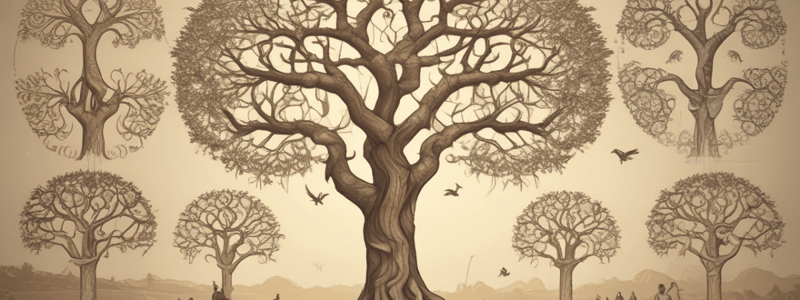Podcast
Questions and Answers
What is a fundamental principle of a clade?
What is a fundamental principle of a clade?
- It consists of descendants but not the ancestor.
- It consists of multiple ancestors.
- It consists of an ancestor and all its descendants. (correct)
- It consists of an ancestor and none of its descendants.
Which of the following is NOT a clade?
Which of the following is NOT a clade?
- Chimps and bonobos
- Orangutans and gorillas (correct)
- Humans and chimps
- Humans, chimps, and bonobos
What does topology refer to in the context of phylogenetic trees?
What does topology refer to in the context of phylogenetic trees?
- The shape of a phylogenetic tree
- The relationships shown in a phylogenetic tree (correct)
- The age of a phylogenetic tree
- The size of a phylogenetic tree
What is a synapomorphy?
What is a synapomorphy?
What is an advantage of using molecular characters in building phylogenetic trees?
What is an advantage of using molecular characters in building phylogenetic trees?
Why are morphological characters sometimes used in tree building?
Why are morphological characters sometimes used in tree building?
What is an example of a non-biological application of phylogenetic analysis?
What is an example of a non-biological application of phylogenetic analysis?
What do the oldest known chess pieces date back to?
What do the oldest known chess pieces date back to?
What is a necessary condition for a group of organisms to be considered a clade?
What is a necessary condition for a group of organisms to be considered a clade?
What type of characters is typically used when building phylogenetic trees using morphological characters?
What type of characters is typically used when building phylogenetic trees using morphological characters?
What is an advantage of using molecular characters in building phylogenetic trees?
What is an advantage of using molecular characters in building phylogenetic trees?
What is the term used to describe the relationships depicted in a phylogenetic tree?
What is the term used to describe the relationships depicted in a phylogenetic tree?
Which of the following is an example of a non-phylogenetic application of phylogenetic analysis?
Which of the following is an example of a non-phylogenetic application of phylogenetic analysis?
What type of characters is typically used when building phylogenetic trees using DNA sequence data?
What type of characters is typically used when building phylogenetic trees using DNA sequence data?
What is a synapomorphy in the context of phylogenetic analysis?
What is a synapomorphy in the context of phylogenetic analysis?
What is a reason why morphological characters are sometimes used in tree building?
What is a reason why morphological characters are sometimes used in tree building?
Flashcards are hidden until you start studying
Study Notes
Clades and Phylogeny
- A clade is a group consisting of an ancestor and all its descendants.
- Examples of clades include chimps and bonobos, and humans, chimps, and bonobos together.
Phylogenetic Trees
- The topology of a tree refers to the relationships shown in the tree.
- A synapomorphy is a shared derived character.
- Clustering algorithms can be used to group similar species together.
Building Phylogenetic Trees
- Morphological characters can be used to build trees, especially in situations where DNA sequence data is not available (e.g., fossil species).
- Similarities in DNA/protein sequence can also be used to build trees.
- Using molecular data is advantageous as it provides thousands/millions of data points for the tree, and is becoming increasingly cost-effective.
Alternative Applications of Phylogenetics
- Phylogenetic trees can be built using non-biological data, such as the phylogeny of chess.
- Chess scholars were divided into 'out of India' and 'out of China' theories, but the oldest known chess pieces date back to 8th century Persia.
- The game of chess is believed to be much older, with variations in board size, piece numbers, roles, and names.
Clades and Phylogeny
- A clade is a group consisting of an ancestor and all its descendants.
- Examples of clades include chimps and bonobos, and humans, chimps, and bonobos together.
Phylogenetic Trees
- The topology of a tree refers to the relationships shown in the tree.
- A synapomorphy is a shared derived character.
- Clustering algorithms can be used to group similar species together.
Building Phylogenetic Trees
- Morphological characters can be used to build trees, especially in situations where DNA sequence data is not available (e.g., fossil species).
- Similarities in DNA/protein sequence can also be used to build trees.
- Using molecular data is advantageous as it provides thousands/millions of data points for the tree, and is becoming increasingly cost-effective.
Alternative Applications of Phylogenetics
- Phylogenetic trees can be built using non-biological data, such as the phylogeny of chess.
- Chess scholars were divided into 'out of India' and 'out of China' theories, but the oldest known chess pieces date back to 8th century Persia.
- The game of chess is believed to be much older, with variations in board size, piece numbers, roles, and names.
Studying That Suits You
Use AI to generate personalized quizzes and flashcards to suit your learning preferences.




